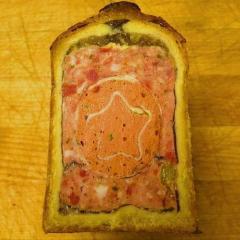Good job, Glen.
I have three questions on this topic:
1. I was just reading the Olympia Provisions book and they recommend starting your salami at 73F for 84 hours until it gets to a pH of 4.8. Other articles I have read recommend starting the cure at 80F for 12 hours, specifically Ruhlman, and use a pH of 4.9 as their target. I have read other articles where they say 5.0 to 5.3 is a fine target. Just about everyone says that if you don't hit their target, throw it out. I just made a high fat salami with chunks of fat in it, the fat coming from a Mangalitsa and the leaner meats from a Tamworth Large Black cross. So the salami is soft because it has such a high fat content. I used Prague #2 and Bactoferm F-RM-52, which contains two strains. The lactobacillus sakei is effective at 30C or 86F and the Staphylococcus carnosus is effective at the same temperature range. I understood that Staphylococcus carnosus was supposed to be effective at much lower temperatures. Is that true? What starter culture is effective at 60F? My salami tastes great and I have eaten quite a bit of it and have not had any ill effects. What exactly is the time, temperature and target pH for such salami? Also, I have just created salami nocciola, from a Yorkshire loin roast, plus coppa and shoulder, which I stuffed into a beef middle. I use Prague #2, of course, and Bactoferm F-RM-52. I also use liberal amounts of wine, which lowers the pH immediately and usually double the amount of dextrose. In this case, I used 1.5X the amount of dextrose but probably should have used more because the pH still in the mid 5s. It takes weeks to lower the pH. The Olympia Provisions books would tell me to throw the salami out. Of course OP uses Bactoferm LHP. I was thinking of using a combination of LHP and F-RM-52. Is that advisable?
2. I used the Bactoferm Mold 600 and on my whole muscle chopped salami stuffed into a beef bung, the mold has taken off. However, not so on my salami nocciola. I used distilled water and several applications of the mold in high concentration, even soaking the mold in the beef middle casing. What gives? My drying room is at 60F and around 65 percent humidity. The beef bung and the beef middle are hanging next to each other.
3. I have a Milwaukee pH meter with the meat probe. This probe does not seem to be a very good one. I calibrate before using the probe each time. Is there a slimmer needle I can use. I do not always tie off my dry sausages into smaller salami but use the full length of the beef middle etc. and this makes testing the pH more difficult. (One solution is to do what I do for my fresh sausage and section them off into smaller links.) Thanks.
Thanks you so much,
Mark.

